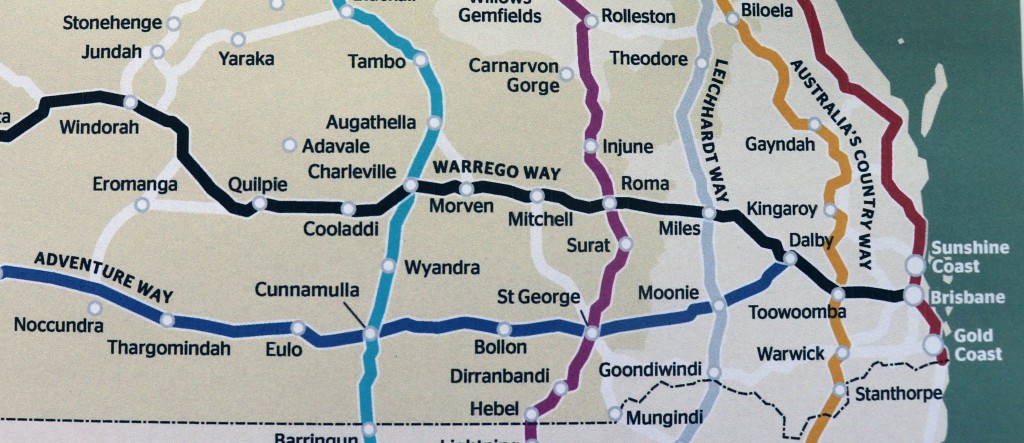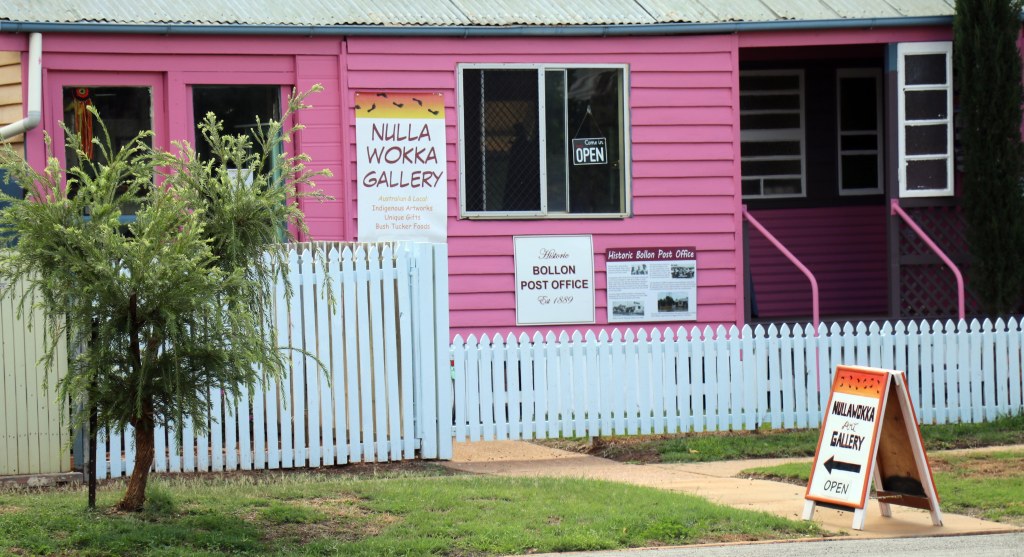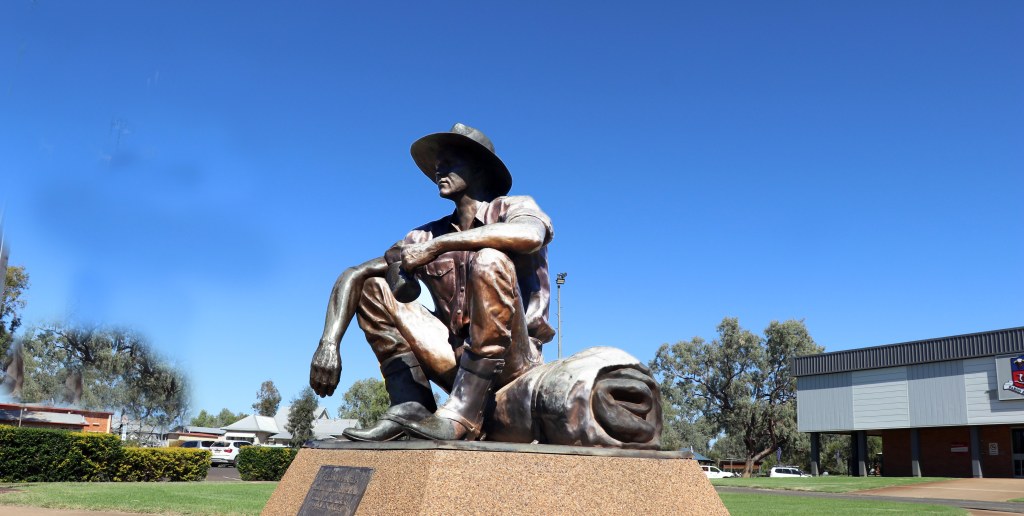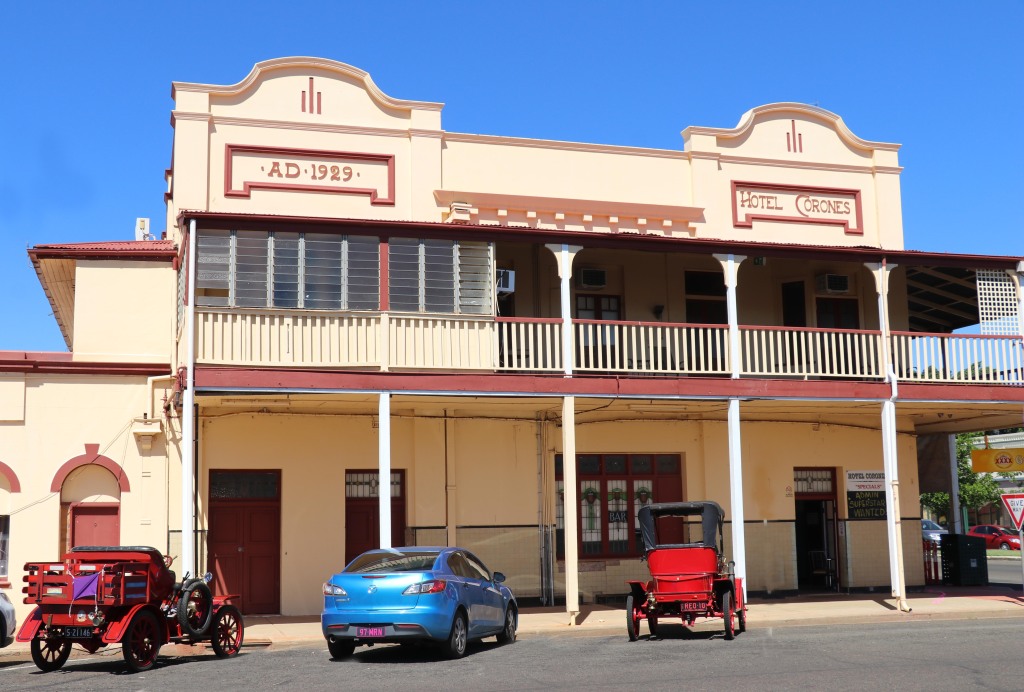Cunnamulla, Charleville, Roma, Brisbane
My journey of exploration – and of childhood nostalgia – into Queensland’s Outback really started, I think, once I left the lovely town of St George and continued to head West. I tapped in GPS directions for Cunnamulla and was told:
- Turn right onto Adventure Way Highway. Stay on Adventure Way for 222 kilometres
I felt that I could set the cruise control, lash the steering wheel and go to sleep for three hours. There was some traffic heading towards me – about one vehicle every ten kilometres – but in the 500 kilometres from St George to Cunnamulla to Charleville there was not a single vehicle in front of me or behind me the whole way.
- I really could have lashed the steering wheel and had a snooze
However, with Mahler’s glorious Fifth Symphony belting out of the CD player it was an easy cruise to the tiny village (population 90) of Bollon and the excellent little Nullawokka First Nations art gallery.
Judith and her First Nations (Gwamu or Kooma mob) husband, Bill Speedy, have a display of local artists’ work with lots of hand-painted emu eggs and many works by local man Tommy Crow, Bill’s friend since their mutual childhood growing up along the banks of the Wallam Creek that flows through this tiny town.
Onwards with the less high-brow sound track to Chicago! echoing through the car to find a sign about 150 km West of St George that welcomed travellers to The Outback.
- Aha! Here at last! Now for desolate wild sweeping red-dirt plains, rugged cowboys and lusty cowgirls wrangling all them ornery cows!
Nope. Not a farm worker or a cow – ornery or not – in sight. Stretching off to distant horizons was vegetation that was slightly more scattered, some slightly stunted trees and some even redder soil glimpsed through surprisingly lush green grass. Small puddles of water and larger dams filled to the top were the result of the recent floods that brought much-needed water to the area.
Coming into Cunnamulla visitors are invited to sample the genuine local camel burgers (I did not), and the first shop I saw was the KA and BJ Maddox store that specialises in groceries … and guns and ammo. A local kid asked me in some wonder why I was taking a photograph of this tiny shop and did not seem to understand why I though it a strange combination:
- Good morning. Yes – I’d like half a dozen eggs please, a loaf of bread, 200 Centrefire rifle cartridges, some butter – oh – and a Browning X-bolt Long Range McMillan 243Win four-round mag rifle please.
Cunnamulla
Cunnamulla was the western-most stop on my journey and has about 1200 people and about 1500 dogs. It is a town of wide streets, with almost no traffic, and seems to be a sleepy sort of a place where most shops and pubs shut down for an hour or two around noon for lunch and a snooze.
The Information Centre – more usually known as the Cunnamulla Fella Centre in honour of the Slim Dusty song of that name – is helpful and has a slightly claustrophobic mine-shaft elevator that seems to go down and back into the past to enable visitors to learn more about the region and the Great Artesian Basin. (1)
Cunnamulla is surrounded – usually – by desert – except when it is flooded. Most houses are raised on stumps to avoid flood waters, and artesian bores do a great job of watering nearby properties. In the town were some of the springiest, greenest, lushest front garden lawns I have seen anywhere. The Cunnamulla Bushlands Walkway (featured image, LEFT) gives an idea of the ironically lush vegetation.
Depending on whom you talk to, average property sizes around Cunnamulla are about 30,000 – 40,000 hectares and increasing to 500,000 – 1 million hectares further West. In three days of travelling I had seen plenty of dogs but not a single cow, and asked a bloke about the lack of cattle.
Gareth told me that drought a few years ago forced many graziers to sell up, but that more destructive is the government’s “Carbon Farming Scheme”. Under the Australian Government’s Emissions Reduction Fund (ERF), graziers are apparently paid significant chunks of cash to stop grazing cattle and to grow brigalow, mulga or wilga trees to help battle carbon dioxide emissions. According to one website (2) there are over 250 carbon farming projects in Queensland – a project in which the State government is investing $500 million dollars.
I wholly support any effort to reduce Australia’s greenhouse gas emissions, but there is a negative side. In the Cunnamulla area alone, some fifteen families have already decided to participate in the ERF, have scrapped their cattle, planted trees … and moved out of the area.
The ERF scheme is good for the environment, but it seems to be killing-off small rural towns and promoting the population drift to the cities.
One day I drifted off to the village of Eulo, about a 120 km round-trip, seeking an opportunity to experience the Great Artesian Basin by having a hot mud bath, or a shower under a scalding-hot artesian bore water pump, or a chance to bump into the infamous Eulo Queen.
Priscilla, Queen of the Desert, is a popular 1990s film with Terence Stamp, Guy Pearce and Hugo Weaving, but there was not much flouncing nor strutting and not a sequin in sight at the pub named for another “queen”, Isabel Robinson, a colourful Eulo figure from the late 1880s.
Eulo has a General Store (currently for sale), a Police Station (closed when I was there), the famous pub, and Paroo Patch, where Tom makes whips and belts and his wife makes handbags. Perhaps there is a Priscilla connection after all … I asked Tom where the mud baths were to be found, only to be told that they – like much of Eulo – were no longer open, and that if I wanted a mud bath the easiest way would be for me to go down to the river and fall face-first in the muddy banks.
I tossed up his advice, decided to give it a miss, and visited a nearby opal shop where I chatted to the owner for a while and finally splurged on a $5.00 chunk of boulder opal. If you look very carefully, you can see a few specks of colour in this otherwise pretty dull-looking rock. Still – I guess I helped the cash-flow of the local community, and then headed back to Cunnamulla for another night at the Billabong Hotel Motel – an unassuming sort of place but a place with great staff and even better meals.
On my final jog around Cunnamulla I saw an Aboriginal flag with what seemed to be a hare or a rabbit imposed on the central circle. Thinking that it might indicate the tribe or mob of the household proudly flying this bit of cultural heritage I asked a bloke nearby who said
- Nah – That’s just the Rabbitohs (a South Sydney football club)
Cunnamulla – Charleville
It is about 200 kilometres from Cunnamulla to Charleville (pop 3,500), and in those two hundred kilometres I saw just thirty vehicles – all coming towards me.
At one stage, 60 km North of Cunnamulla we had a major traffic jam.
I was heading North, two other cars were heading South and one of them daringly decided to turn right to head off into the West. Fortunately, a kindly policeman was there with flashing batons and tootling whistles to help unjam the traffic jam and after a short time all three cars were able to get untangled and to head on their respective ways …
A railway line runs parallel to the main road between C and C.
Travellers used to be able to take the Westlander train from Brisbane to Charleville (a 777 kilometre and seventeen-hour journey), and then take a rail motor to Cunnamulla. However, in 2014 a truckload of fifty-three tonnes of ammonium nitrate crashed at the Angellala Bridge, thirty or so kilometres south of Charleville. The truck caught fire and exploded, and the road and railway bridges were destroyed. While the road now has a fine new bridge, the railway has been left high and dry and travellers now have to walk … or catch a bus.
Corones Hotel
I had reserved a couple of nights at the historic Corones Hotel – perhaps one of Queensland’s most famous Outback pubs.
This grand dame (3) of the West has played hostess to Australian Prime Ministers, members of the British Royal family, the famous aviatrix Amy Johnson (first woman to fly solo from Britain to Australia) and entertainers ranging from Gracie Fields and Australian Rock ‘n’ Roll legend Johnny O’Keefe.
And me.
A local woman offers excellent and informative historic tours of the hotel which allow participants to see areas not usually available even for hotel residents. Rachel’s knowledge of the building and of the family that built and ran it is encyclopaedic. However, I was not ready for her most fascinating historical titbit.
Harry Corones built the hotel in the 1920s and his son Peter eventually took over the management of the place. According to Rachel, another son, George, went on to become a General Practitioner and later resumed his life-long fascination for competitive swimming. George died in 2020 aged 101, but in the late 1940s he had married Thelma, my mother’s cousin. So George was a Great Uncle to us, and his father Harry was Great Great Uncle (or something) Harry Corones.
It was a delicious twist of history to have been visiting a Heritage-listed building and to learn of our family link – albeit somewhat remote – to the hotel.
Charleville Delights
My visit happened to coincide with an event that last occurred in Charleville in 2006. A national rally for the Veteran Car Club was being held for one- and two-horsepower cars and motorbikes.
These vehicles – none of them any younger than 102 years old – were driven through the town streets by their proud owners – many about the same age and many dressed in fashions from the era. The sunset parade along Galatea Street was a highlight as the cars puttered and stammered their way through the gathered crowds, leaving behind them clouds of non-politically correct exhaust fumes.
Outback Landscapes
My visit also coincided with the opening of a wonderful exhibition of new works by local artist Wayne Rasmussen. When not working as an artist, Rasmussen is a Police Inspector responsible for eleven remote police stations scattered through Outback Queensland, New South Wales and South Australia.
I hope he is as good a copper as he is an artist.
His exhibition featured about fifty recent works – all re-imaginings of discarded road signs, using acrylic, fluorescent and phosphorescent paints as well as found objects – beer bottle tops, teddy bears, soft drink cans ring pulls and broken keys. Holes punched into the road signs by kangaroo hunters sighting-in their hunting rifles have been made features of the artworks: who could have imagined that destruction could become part of creation?
Flying Doctor, USAF, Faraway Stars
There’s plenty to do in Charleville.
A visit to the historic Royal Flying Doctor is a must. In the vast area of the Outback, the nearest medical help may be hundreds of kilometres away. In 1928 the first Flying Doctor took off when John Flynn opened the Australia Inland Mission Aerial Medical Service in Cloncurry. Today, remote cattle stations can radio for assistance and be talked through their own on-site medical kits
- Use the wide bandage – Item 220 in the bottom drawer then a sling – Item 219 – in second drawer
In more urgent cases an aeroplane with medical staff will be launched to effect a medevac bringing the patient to the nearest hospital.
Flights of quite a different sort were common during World War II when 3,500 USA airmen were stationed in Charleville – a boon to the local economy and perhaps also to the local ladies. A “Top Secret” base was established for long-range bombers and to keep secret the workings of the famous Norden bomb sight that gave Allied forces a greater degree of accuracy on their bombing missions over war-torn Asia.
An interesting tour is available through the “Top Secret WWII Base” just outside Charleville, near the fascinating Cosmos Centre and Observatory.
Because of the many charms of Charleville, I am told that its population is slowly increasing. The main industry used to be sheep, but according to one local bloke
- All the sheep all got eaten out by wild dogs. Well, they call ‘em wild dogs but they are dingoes
After the government paid for the installation of many kilometres of anti-dog fences, graziers gradually regained confidence and reintroduced sheep to complement the beef cattle that had previously taken their place. I was told that, curiously, the largest local employer is WME – Western Meat Exporters – who produce Halal goat and sheep meat for the Middle East, Belgium, the Congo Republic, Russia, Singapore and many other countries including Vietnam.
Perhaps because of its export markets, or perhaps because of their work ethic, most staff at WME are Cambodians or Vietnamese. Despite stories of “redneck” attitudes in some rural communities, I was happy to hear that the Vietnamese and Cambodians are very welcome members of the Charleville community, and that the Head Prefect at the local High School last year was a Vietnamese girl.
Charleville to Clayfield
After almost 800 kilometres from St George to Cunnamulla to Charleville to Mitchell, I finally saw some beef cattle grazing near Amby, just outside Mitchell. Damned elusive these steers, bulls, bullocks, weaners, heifers, calves and cattle (4)! Mitchel also offers The Great Artesian Spa.
Aha! I thought! I can finally have that hot tub or a deep mud bath or get scrubbed by lusty cowgirls or cowboys with revitalising salts and organic minerals. Nope. The Great Artesian Spa is a pleasant place for a casual dip, but it offers only a rather tepid bathing pool with chlorinated waters, and a slightly colder pool – also chlorinated. No facials. No scrubs.
The bustling town of Roma (pop 8,100) has what sounds a rather prosaic name – until you discover that is was named for Lady Bowen, Countess Diamantina di Roma, wife of the first Governor of Queensland.
Roma is well-known for the lovely stained-glass windows in St Paul’s church, for the marvellous bottle trees lining the streets, for the first traffic lights I had seen in more than 1500 kilometres, and for The Big Rig, that gives the history of local oil and gas fields. But for me the main attraction was the massive complex of the Roma Saleyards, where 6000 cattle were sold on the day of my visit in a superbly well-organised operation. As I had not seen any cattle on my travels, I guess all 6000 had been hiding from me … somewhere. On a busy day, up to 14,000 beasts may fall under the auctioneer’s hammer.
The Warrego Way then slices South East through rich grazing fields from Roma to Dalby (pop 14,000, a town where I attended school for one month in 1956) and on to Goombungee (pop 800) where my family lived in the 1960s, to Toowoomba (170,000 happy little farmers), through wide paddocks of cabbages in the Locker Valley and finally to Clayfield in Brisbane (2.3 million) and the end of my outback jaunt of about 2,300 km – about the distance from Boston Massachusetts to New Orleans Louisiana.
……………………………………..
Notes
- The Great Artesian Basin is one of the largest underground freshwater resources in the world. It is Australia’s largest groundwater basin. The Basin spans almost 1.7 million square kilometres (over one-fifth of the Australian continent) and has a storage capacity of 64,900 million ML. It connects with the Murray–Darling Basin and the Lake Eyre Basin and lies beneath parts of the Northern Territory, Queensland, South Australia and New South Wales. For details visit: www.agriculture.gov.au/water/national/great-artesian-basin
- See www.qld.gov.au/environment/climate
- https://en.wikipedia.org/wiki/Hotel_Corones
- According to information supplied by the Roma Saleyards:
Cows: Mature females that have given birth to at least one calf
Calf: A beast that has not yet reached maturity
Weaner: A calf that has been weaned off its mother’s milk and is usually
less than twelve months old
Heifer: A mature female beast that has not yet calved
Bull: An un-castrated male
Steer: A castrated male beast
……………………………………..
Text and photographs © Christopher Hall April 2021
……………………………………..
In my blogs I try to present a snapshot of the places I have discovered during a brief visit. I am not trying to present a detailed picture of the whole city or the whole region or the whole country.
……………………………………..
If you enjoyed this story please scroll down to see earlier stories and forward the blog address to your friends: www.hallomega.com
If you would like to receive automatic notification of future postings on this blog please click the FOLLOW button on your screen.
……………………………………..
If a man ascended into heaven and gazed upon the whole workings of the universe and the beauty of the stars, the marvellous sight would give him no joy if he had to keep it to himself. And yet, if only there had been someone to describe the spectacle to, it would have filled him with delight.
……………………………………..















Good trip and story. Love the photo of the guy driving the old car
LikeLike
Thanks Paul – There were SO many photo ops of veteran car drivers in period dress! I liked this man’s concentration …
LikeLike
Thanks Chris for taking us on your journey – great to be out and about!!!
Sent from Mail for Windows 10
LikeLike
I don’t think I can easily imagine such big distances with so few other people! Looks as if it was an interesting trip.
LikeLike
Hello Lynda – yes – a great experience and there were plenty of opportunities to meet people and to chat … or to enjoy the huge silence!
LikeLike
Hi Chris,
Really enjoyed your latest blog Chris, I thought I was in all these small outback towns. I would love to do that trip – perhaps I will persuade Vicki when this is all over.
Priscilla Queen of the Desert is one of my Top 10 films, I have a DVD of it which I think I got in China!!!
I think we were a bit complacent here Chris, but now we are feeling what people in other countries have been through. This wave of the virus came in thick and fast and the streets are empty, it is a joy to drive down Nimmen though!!
I have just put my flat on the market, I will be 70 in June and I feel like I need to make decisions for my next adventure. Not having to worry about the flat would make it easier. Have you sold yours yet Chris?
Anyway, keep the travel blogs coming, especially now that we cannot move out of Chiang Mai, let alone go overseas.
Kind regards, Linda.
*Linda Buck *
Director of External Relations
234 Moo 3, T. Huay Sai, A. Mae Rim, Chiang Mai 50180
Tel: +66 53 301 500 | Mobile: (66) 87 191 3807
LikeLike
A great blog Chris. You certainly did the west.
LikeLike
Thanks Judy – it was certainly a pleasant couple of weeks on the road!
LikeLike